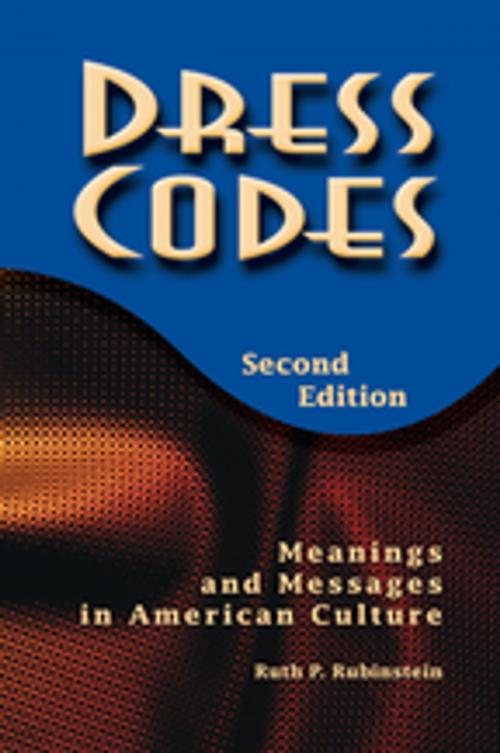Dress Codes
Meanings And Messages In American Culture
Nonfiction, Social & Cultural Studies, Social Science, Sociology| Author: | Ruth Rubinstein | ISBN: | 9780429974915 |
| Publisher: | Taylor and Francis | Publication: | May 4, 2018 |
| Imprint: | Routledge | Language: | English |
| Author: | Ruth Rubinstein |
| ISBN: | 9780429974915 |
| Publisher: | Taylor and Francis |
| Publication: | May 4, 2018 |
| Imprint: | Routledge |
| Language: | English |
Rich with illustrations, this revised and updated second edition of Dress Codes systematically analyzes the meaning and relevance of clothing in American culture. Presented here is an up-to-date analysis of images of power and authority, gender, seduction (the sexy look, the alluring look, the glamorous look, the vulnerable look), wealth and beauty, youth and health, and leisure and political hierarchy. Taken together, the chapters offer to the student and the general reader a complete "semiotics of clothing" in a form that is highly readable, very entertaining, and thoroughly informative. The illustrations provide fascinating glimpses into the history of American fashion and clothing-along with their antecedents in Europe-as well as a fine collection of images from the more familiar world of contemporary America.Rubinstein has identified six distinct categories of dress in American society, upon which Dress Codes is based. "Clothing signs" were instituted by those in authority, have one meaning, indicate behavior, and are required attire (police uniforms, or the clothing of ministers and priests); ?clothing symbols," on the other hand, reflect the achievement of cultural values?wealth, beauty, you and health. The wearing of clothing symbols?designer clothing or jewelry?may have several meanings; '`'clothing tie-signs,? which are specific types of clothing that indicate membership in a community outside mainstream culture (Hasidic, Amish, or Hare Krishna attire). They were instituted by those in authority, have one meaning, they indicate expected behavior, and are required attire; clothing tie symbols emanate from hopes, fears, and dreams of particular groups. They include trendy styles such as hip-hop, hippie, and gothic. Another category, contemporary fashion, reflects consumer sentiments and the political and economic forces of the period. Personal dress, refers to the "I" component we bring in when dressing the public self (bowtie, dramatic, or artistic attire). Many of these images have their roots in the collective memory of western society. Written in a lively and entertaining style, Dress Codes will fascinate both general readers and students interested in the history of fashion and costume, fashion design, human development, and gender studies.
Rich with illustrations, this revised and updated second edition of Dress Codes systematically analyzes the meaning and relevance of clothing in American culture. Presented here is an up-to-date analysis of images of power and authority, gender, seduction (the sexy look, the alluring look, the glamorous look, the vulnerable look), wealth and beauty, youth and health, and leisure and political hierarchy. Taken together, the chapters offer to the student and the general reader a complete "semiotics of clothing" in a form that is highly readable, very entertaining, and thoroughly informative. The illustrations provide fascinating glimpses into the history of American fashion and clothing-along with their antecedents in Europe-as well as a fine collection of images from the more familiar world of contemporary America.Rubinstein has identified six distinct categories of dress in American society, upon which Dress Codes is based. "Clothing signs" were instituted by those in authority, have one meaning, indicate behavior, and are required attire (police uniforms, or the clothing of ministers and priests); ?clothing symbols," on the other hand, reflect the achievement of cultural values?wealth, beauty, you and health. The wearing of clothing symbols?designer clothing or jewelry?may have several meanings; '`'clothing tie-signs,? which are specific types of clothing that indicate membership in a community outside mainstream culture (Hasidic, Amish, or Hare Krishna attire). They were instituted by those in authority, have one meaning, they indicate expected behavior, and are required attire; clothing tie symbols emanate from hopes, fears, and dreams of particular groups. They include trendy styles such as hip-hop, hippie, and gothic. Another category, contemporary fashion, reflects consumer sentiments and the political and economic forces of the period. Personal dress, refers to the "I" component we bring in when dressing the public self (bowtie, dramatic, or artistic attire). Many of these images have their roots in the collective memory of western society. Written in a lively and entertaining style, Dress Codes will fascinate both general readers and students interested in the history of fashion and costume, fashion design, human development, and gender studies.















